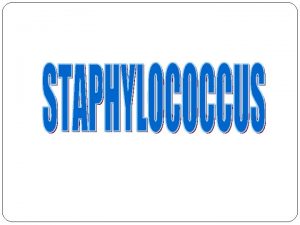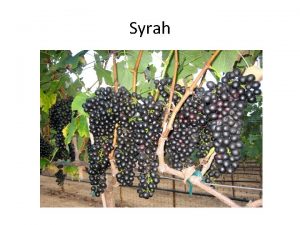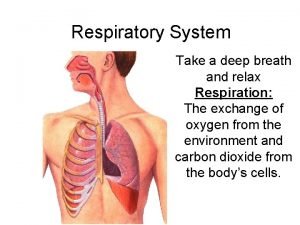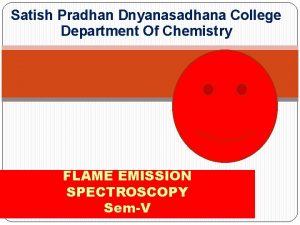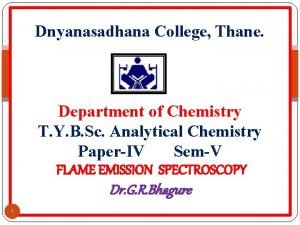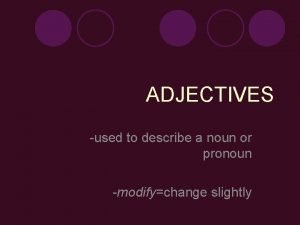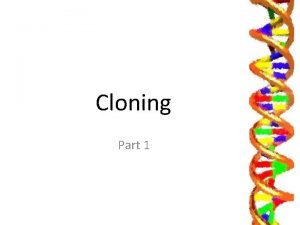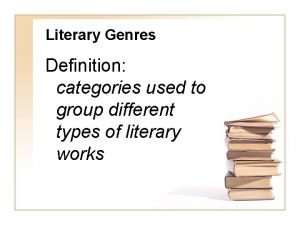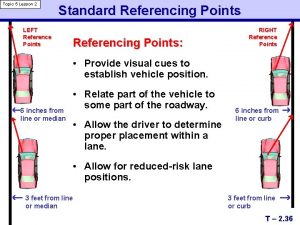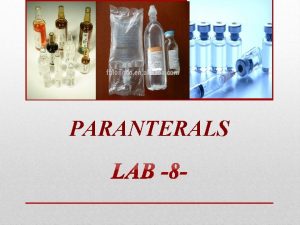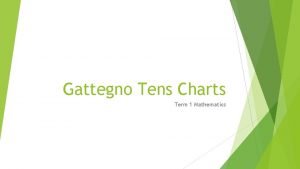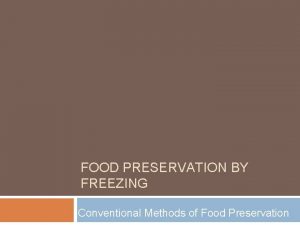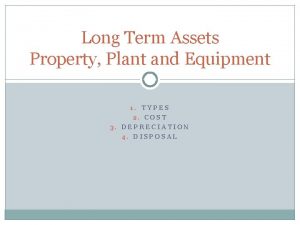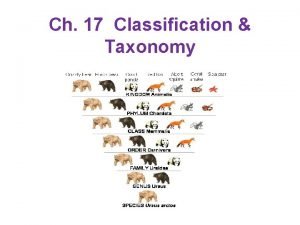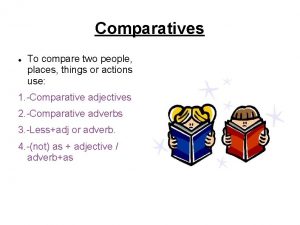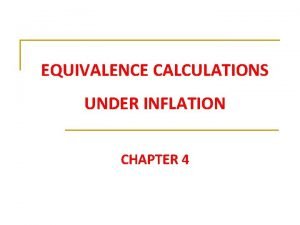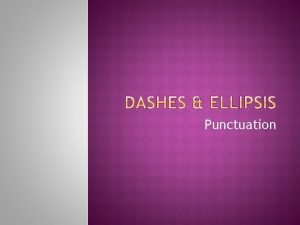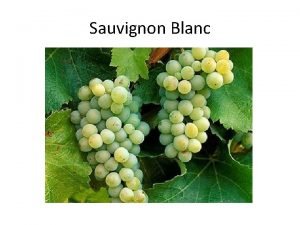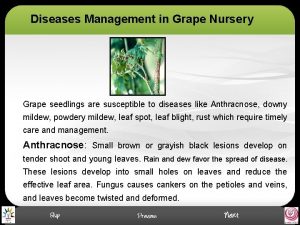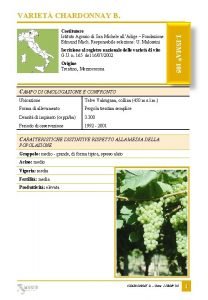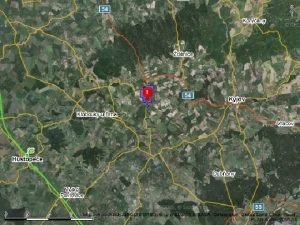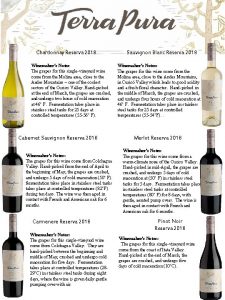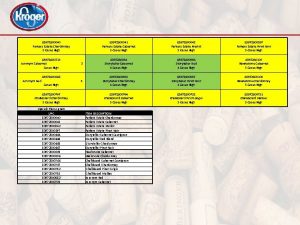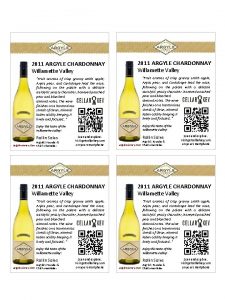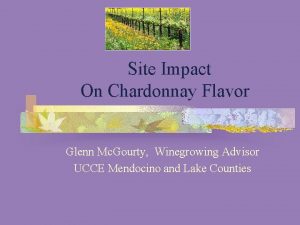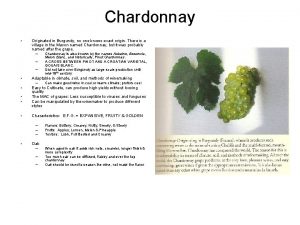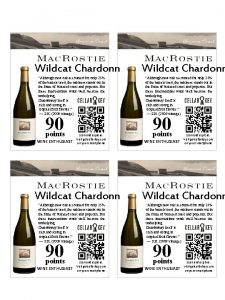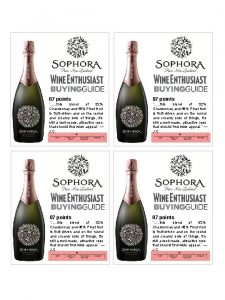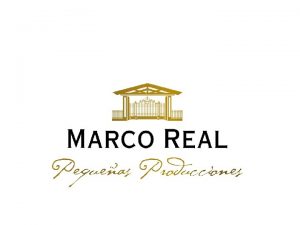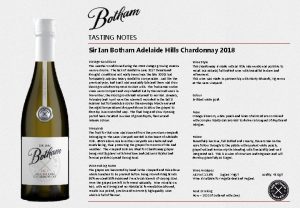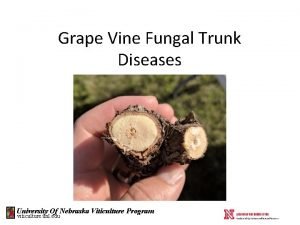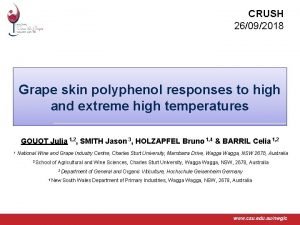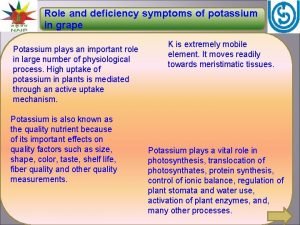Chardonnay Chardonnay is a greenskinned grape used to


































































- Slides: 66

Chardonnay

Chardonnay is a green-skinned grape used to make white wine

It originated in the Burgundy wine region of eastern France

Chardonnay is a cross between the Pinot Blanc and Gouais Blanc grape varieties

Chardonnay is planted in more wine regions than any other grape

Chardonnay is easy to cultivate and is adaptable to different conditions The grape reflects its terroir and winemaker

There is not one universal "style" to Chardonnay made across the globe

It is vinified in many different styles, from the lean, crisply mineral wines of Chablis, France to New World wines with oak, and tropical fruit flavors.

Styles are regionally based: Pineapple Notes-Napa Valley Green Apples-Chablis

Winemaking Chardonnay can be used with any style of wine making from dry still wines, to sparkling wines to sweet late harvest and even botrytized wines.

Many examples of Chardonnay can benefit from a few years of bottle aging, but most Chardonnays are meant to be consumed in their youth

Chardonnay can adapt to almost all vineyard soils, the types it seems to like most are chalk, clay and limestone

Time of harvest is crucial as the grapes quickly begin to lose acidity as they ripen

The two winemaking decisions that most widely affect the wine: Malolactic Fermentation Degree of Oak Influence

The amount of charring will determine the level of "toastiness”

Other winemaking decisions that effects the flavor of the wine: Temperature of Fermentation Time, if any, on the lees

Colder fermentation produces more "tropical" fruit flavors like mango and pineapple

Burgundian winemaking favor extended contact on the lees bâttonage-"stirring up" the lees

France In France, Chardonnay is the second most widely planted white grape variety just behind Ugni blanc

The grape first rose to prominence in the Chablis and Burgundy regions.

France-Burgundy Chardonnay is one of the dominant grapes in Burgundy

In addition to being the most expensive, the Burgundy examples of Chardonnay are considered the benchmark standard of expressing terroir through Chardonnay.

It is grown in 8 Grand Cru Vineyards; “The Montrachets” Montrachet, Criots-Bâtard-Montrachet, Bâtard. Montrachet, Chevalier-Montrachet, Bienvenues-Bâtard. Montrachet as well as Charlemagne, Corton. Charlemagne & Le Musigny

They have high alcohol levels, often above 13% & deep concentration of flavors Chassagne-Montrachet-hazelnut aroma Puligny-Montrachet-steely flavors.

Côte Chalonnaise Mercurey Montagny-lès-Buxy Rully (The largest producers of Chardonnay in the Côte Chalonnaise)

Mâconnais Production is centered around the town of Mâcon and the Pouilly -Fuissé region.

Chablis Chardonnay is the only permitted AOC grape variety in the region

Chardonnay in Chablis is one of the "purest" expressions of the varietal character due to the simplistic style of winemaking

The wines rarely go through malolactic fermentation and are usually not exposed to oak (though its use is increasing)

The winemakers that do use oak tend to favor more neutral oak to avoid the vanilla characteristic associated with American oak

Champagne Chardonnay is one of three major grape varieties planted in the region The others- Pinot Noir & Pinot Meuniere

The element that Champagne wine-makers look for is the finesse and balance of acidity Flavors that emerge from extended time on its lees: Creamy, Nutty, Floral

North America, particularly California, produces a style of wine that is noticeably different than that of France It is the dominant white variety, overtaking Riesling in 1990

In the United States it is found most notably in California, Oregon, Texas, Virginia and Washington but also in Alabama, Arizona, Arkansas, Colorado, Connecticut, Georgia, Idaho, Illinois, Indiana, Iowa, Maryland, Massachusetts, Michigan, Minnesota, Missouri, New Hampshire, New Jersey, New Mexico, New York, North Carolina, Ohio, Oklahoma, South Carolina, Tennessee and Vermont wine.

In Canada, Chardonnay is found in British Columbia, Nova Scotia, Ontario and Quebec

California The first successful commercial production was in the Livermore Valley AVA Wente Vineyards developed a clone that was used in many Californian vineyards throughout the 1940 s

The early trend was to imitate the great Burgundy wines

1976 - Chateau Montelena's victory over Burgundy Chardonnay in the blind tasting event conducted by French judges known as the Judgment of Paris

In the 1970 s, the focus was on harvesting at higher degrees of ripeness and at higher Brix levels New oak barrels were used to produce wines that were big in body, mouthfeel and alcohol.

The wine regions with coastal fogs produce premium level wines The fogs slow the ripening of the grapes and give them more time to develop their flavors

Alexander Valley, Los Carneros, Russian River Valley & Sonoma Have great success producing wines that reflect Burgundian styles

Other regions often associated with Chardonnay include Napa Valley, Monterey County and Santa Barbara County

New York Chardonnay was one of the first European grape varietals to have been grown commercially east of the Rocky Mountains. Finger Lakes region of upstate New York

New York’s comparatively cool growing season: Slower ripening & a Longer hang time The grapes develop greater complexity at reasonable sugar levels compared to warmer Chardonnay regions

Washington Chardonnays can be similar to Californian Chardonnays with more emphasis on fruit than creaminess

Washington vineyards are planted with clones from The University of California. Davis Designed to take longer to ripen in our warmer weather. This allows winemakers to maintain the acidity levels that balance the fruity and earthiness of Washington Chardonnay

Apple notes are common and can range from flavors of Golden Delicious and Fuji to Gala and Jonathan

Oregon Chardonnays can be very similar to French Chardonnays but with a little more body.

Australia & New Zealand Best from South Australia, New South Wales and Victoria. 1971 - one of the first commercially successful Chardonnays is produced by Murray Tyrrell in the Hunter Valley

Tyrell's vineyard was planted with cuttings that he "borrowed" from Penfolds' by jumping their barb-wire fence and pruning their vines

To compensate for the very warm climate, richness is enhanced by the use of oak chips and acid is added during fermentation

Italy For most of its history in Italian winemaking Chardonnay was and still is a blending grape

In Lombardy, the grape is often used for spumante.

In Spain, Chardonnay is increasingly used in the sparkling wine Cava.

Portugal The Portuguese have been mostly influenced by flying winemakers from Australia and the wines produced are very New World in style

Chile/Argentina In the cool-climate wine regions of Argentina's Uco Valley and Chile's Casablanca, Chardonnay has developed a presence

With Food Due to the wide range of styles, Chardonnay has the potential to be paired with a diverse spectrum of food types.

It is most commonly paired with white meats

Heavily Oaked Chardonnays do not pair well with light seafood dishes These wines tend to go better with smoked fish, spicy southeast Asian cuisine and garlic dishes

Chardonnays from Washington, which have more acidity, pair well with tomato-based dishes and items featuring sweet onions

Older, more mellow Chardonnays are often paired with more "earthy" dishes like mushroom soup and aged cheese

"Chardonnay” Arboisier, Arnaison Blanc, Arnoison, Aubaine, Auvergnat Blanc, Auvernas Blanc, Auvernat Blanc, Auxeras, Auxerras Blanc, Auxerrois Blanc, Auxois Blanc, Bargeois Blanc, Beaunois, Biela Klevanjika, Blanc de Champagne, Blanc de Cramant, Breisgauer Suessling,

Breisgauer Sussling, Burgundi Feher, Chablis, Chardenai, Chardenay, Chardenet, Chardennet, Chardonay, Chardonnet, Chatenait, Chatey Petit, Chatte, Chaudenay, Chaudenet, Chaudent, Clävner, Clevner Weiss, Cravner, Epinette Blanc, Epinette Blanche, Epinette de Champagne, Ericey Blanc, Feher Chardonnay, Feherburgundi, Feinburgunder, Gamay Blanc, Gelber Weissburgunder, Gentil Blanc, Grosse Bourgogne, Klawner, Klevanjka Biela, Klevner,

Luizant, Luzannois, Maconnais, Maurillon Blanc, Melon D'Arbois, Meroué, Moreau Blanc, Morillon Blanc, Moulon, Noirien Blanc, Obaideh, Petit Chatey, Petit Sainte-Marie, Petite Sainte Marie, Pineau Blanc, Pino Sardone, Pino Shardone, Pinot Blanc à Cramant, Pinot Blanc Chardonnay, Pinot de Bourgogne, Pinot Giallo, Pinot Planc,

Plant de Tonnerre, Romeret, Rouci Bile, Rousseau, Roussot, Ruländer Weiß, Sainte Marie Petite, Sardone, Shardonne, Später Weiß Burgunder, Weiß Burgunder (normally refers to Pinot Blanc), Weiß Clevner, Weiß Edler, Weiß Elder, Weiß Klewner, Weiß Silber, Weißedler, Weißer Clevner, Weißer Ruländer.

Chardonnay is a wine that one can use to explore the whole world!
 Alanis morissette spoons
Alanis morissette spoons Gram positive cocci grape-like cluster
Gram positive cocci grape-like cluster Grape solar 390w
Grape solar 390w Grape life cycle
Grape life cycle Dark skinned grape
Dark skinned grape Respiratory system
Respiratory system Logo diffusion
Logo diffusion Grape countable or uncountable
Grape countable or uncountable Grape sherbet poem
Grape sherbet poem In a premix burner used in fes the fuel used is
In a premix burner used in fes the fuel used is In a premix burner used in fes the fuel used is
In a premix burner used in fes the fuel used is Words that describe nouns and pronouns
Words that describe nouns and pronouns What are aaawwubbis words used for
What are aaawwubbis words used for What is output devices
What is output devices Little nicky (cat)
Little nicky (cat) Use garnish in a sentence
Use garnish in a sentence Categories used to group different types of literary work
Categories used to group different types of literary work Reference points driving
Reference points driving Deferable server approach is used for
Deferable server approach is used for A grid used with extraoral imaging:
A grid used with extraoral imaging: Capacitance manometer wikipedia
Capacitance manometer wikipedia Processing used materials into new products
Processing used materials into new products Leaker test for parenterals
Leaker test for parenterals Lam 4520 xle
Lam 4520 xle How can ngt be used for requirements determination
How can ngt be used for requirements determination Changing position of helpless patient
Changing position of helpless patient Notching hair definition
Notching hair definition Promotional channels
Promotional channels Gattegno chart decimals
Gattegno chart decimals Input devices in virtual reality
Input devices in virtual reality Examples of claim and counterclaim
Examples of claim and counterclaim Commas with interrupters
Commas with interrupters Chi square critical value table
Chi square critical value table Freezing techniques used in the food industry
Freezing techniques used in the food industry Citing many authors
Citing many authors Types of desizing
Types of desizing Stagecraft tools
Stagecraft tools Past participle used as an adjective
Past participle used as an adjective Figure of speech used in aunt jennifer's tigers
Figure of speech used in aunt jennifer's tigers Name the four pin curl bases and their uses
Name the four pin curl bases and their uses Ciara harte
Ciara harte Slotted plastic tip on arrow
Slotted plastic tip on arrow Plant assets are used in operations
Plant assets are used in operations Which seedless plants have been used to treat bee stings?
Which seedless plants have been used to treat bee stings? Liger taxonomy
Liger taxonomy Story paragraph
Story paragraph Brake lathe setup
Brake lathe setup Beardmore used cars
Beardmore used cars The druids may have used stonehenge dgp
The druids may have used stonehenge dgp Can varargs be used in abstract method
Can varargs be used in abstract method Comparing 2 people
Comparing 2 people Hit transformation
Hit transformation Units of measurement in physics
Units of measurement in physics Traditional mirror settings should be used
Traditional mirror settings should be used Define expository essay
Define expository essay Inflation formula
Inflation formula Why are seedless vascular plants important
Why are seedless vascular plants important What is the message of the story hey come on out
What is the message of the story hey come on out A nylon rope used by mountaineers elongates
A nylon rope used by mountaineers elongates How to use ellipses
How to use ellipses Bc and ad timeline
Bc and ad timeline Mirror that curves outward and use in convenience store
Mirror that curves outward and use in convenience store Did you used to wear glasses
Did you used to wear glasses Longjax mht benefit
Longjax mht benefit Straddle slide technique
Straddle slide technique Draw sheets are used to
Draw sheets are used to Symbols used in building drawing
Symbols used in building drawing

